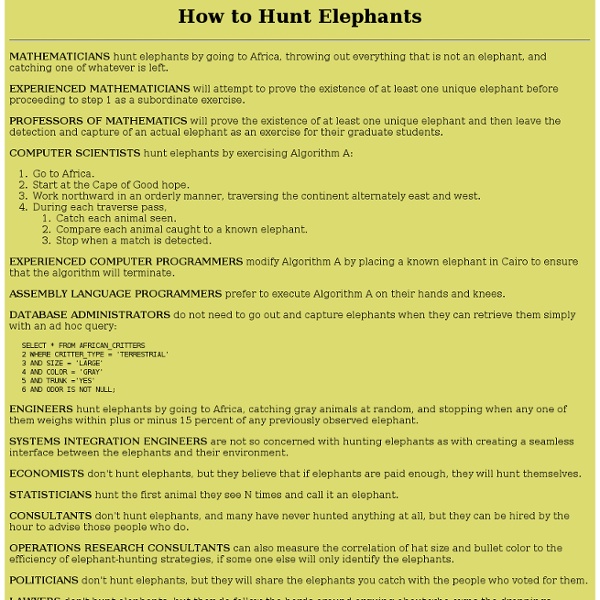Eight Absurd Texts That Make You Wish Your Mom Didn't Have An iPhone |... - StumbleUpon
Dad’s Birthday Surprise Mom Always Knew Mom Discovers Internet Lingo That’s No Way To Celebrate Your Anniversary What Do Dad And Mondays Have In Common? Mom Watched A Dateline About Push Pops This Is Awkward I Almost Think It’s On Purpose… Hot On The PBH Network & The Web
Most Popular of All Time
See also: the most popular from the last 30 days. David Vanderbyl Only a few blocks from home my 3-year-old brother opened the rear door of our family's Dodge Polara, and quick as a wink he was gone. tags: childhood drama [add] 2006-09-02 19:10:06 / Rating: 7330.25 / ferdinandthebull When I was 5 or so my mom would tell me to lie down before she tied my tie and I just now realized at the age of 19 that she did this because she's a funeral director. tags: funeral disenchanted humor [add] 2008-04-08 16:46:37 / Rating: 7305.5 / What are the odds? I knew God had a sense of humor when I hesitantly answered the ringing K-Mart payphone, only to hear my best friend, who had misdialed my home phone number, on the other end. tags: coincidence telephone humor friends God random [add] 2008-06-10 10:39:09 / Rating: 6474 / Ashamed My atheist neighbor has helped more people in the past year than my entire congregation has in the past ten. tags: religion shame hypocrite ashamed atheist atheism [add] Alexandra Limey Tom
Fascinating Lamps by Calabarte | Pondly
Calabarte is the pseudonym of a Polish artist named Przemek Krawczynski, whose art takes on a peculiar but incredibly beautiful form: cool lamps. The name itself is a portmanteau of two words – art (obviously), and calabash, the fruit that carries his imagination. The calabash is a bottle gourd originating in India, although Calabarte gets his supply from Senegal. Due to ancient domestication and usage, the bottle gourd has an incredibly tough outer shell. Due to the combination of dark, thick material with a light source within, the primary art of his work, however, shines in the dark. Hard work, beauty, an exceptional degree of detail and a marriage between mathematical geometry and a rampant imagination – all imprinted onto the husk of a Senegal calabash. Described as the art of light, Calabarte’s artistic tendencies truly took off in 2009, when he made his first gourd lamp, by chance of coming across a calabash. Website
40 Witty Campaign Posters for a Cause
Non-profit organizations use posters to deliver a particular message. These help inform people about current issues, problems and even the possible consequences of their actions. With a sentence that contains strong words or images, these posters give more impact than common commercial posters. To give you an idea, here are 20 sample campaign posters to provoke your imagination. Enjoy! Wildlife is becoming harder to find in Vietnam. Winter. Who are the real monsters? When they speak, we listen. Shit is not a cool band. Say no to child labor. Can you treat yourself better than your doctor? Nothing we do will ever bring them back. Please don’t dive with white sharks. All under 25 who are sexually active should test for Chlamydia every year and avery time they change partner. For some people, life is that expensive. Preparing today reduces the consequences of disaster tomorrow. Two thirds of college students in Mississippi don’t smoke. Please clean up after your dog. One mistake is all it takes.
What Happened Bandages
We regularly look for fresh and high quality fonts for designers and bring them together.We found many fresh fonts but selected really good ones.Personally i like Kakawate,Conviction and Hand-up fonts so much More Free Fresh Fonts
The Astounding Design Of Eixample, Barcelona
Constructed in the early 20th century, Eixample is a district of the Spanish city of Barcelona known for the urban planning that divided the district into octagonal blocks. Influenced by a range of schools of architecture, Eixample Barcelona was designed in a grid pattern with long streets, wide avenues, and rounded street corners. Despite being in the center of a thriving European metropolis, the district provides improved living conditions for inhabitants including extensive sun light, improved ventilation, and more open green space for public use. And of course, the result from the grid-like structure is astounding from above:
CollegeHumor's X-Men Guide To Puberty By Caldwell Tanner [Webcomic
Following up on his exploration of superhero sex positions, CollegeHumor cartoonist Caldwell Tanner is back with another intimate series based on the personal lives of some of our favorite comic book characters. In the “What’s Happening To My Body?” Book For Mutants, Tanner casts Professor X as a sex education teacher giving his mutant students some crucial understanding of their variously horrible bodily functions. You can see the whole series at CollegeHumor. For more Caldwell Tanner, click here. [Via I forgot]
halloween cakes
While we here at ES put most of our Halloween energy into thinking up weird food costumes, we’ve noticed in the past couple of years that our friends around the blogosphere and flickr-verse have been getting crazy creative with the cakes for this particular holiday season. Since you know we can’t bake to save our lives, let’s take a look at a few of the freakiest, loveliest cakes we’ve spied around the web. 10. (Pag asa) 9. (Dessert by Candy — includes full recipe) 8. (Williams-Sonoma, where you can actually buy a $99 pan specifically for making this cake) 7. (My Own Sweet Thyme — includes step-by-step instructions.) 6. (megpi) 5. (Don Buciak) 4. (Make) 3. (Crafster) 2. (Cleverswine) (plus recipe here) 1. (Do It Myself! What other kinds of cakes are all you weirdos baking! All of our Halloween costumes, cocktails and recipes — in Endless Halloween Sponsored Content



